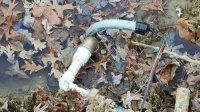Brettrice550
New Member
I recently had a new submersible pump, switch, water heater, and plumbing lines installed in my house. I am using the same pressure tank from the previous owner. When the pump is on, I instantly reach 20 psi. When the pump is off, the pressure goes to 0. I never achieve the 40-60 psi for the switch to work. I have run the system for 10-15 minutes at a time with no faucets open and all faucets open. I am not sure what the issue is. Advice?

